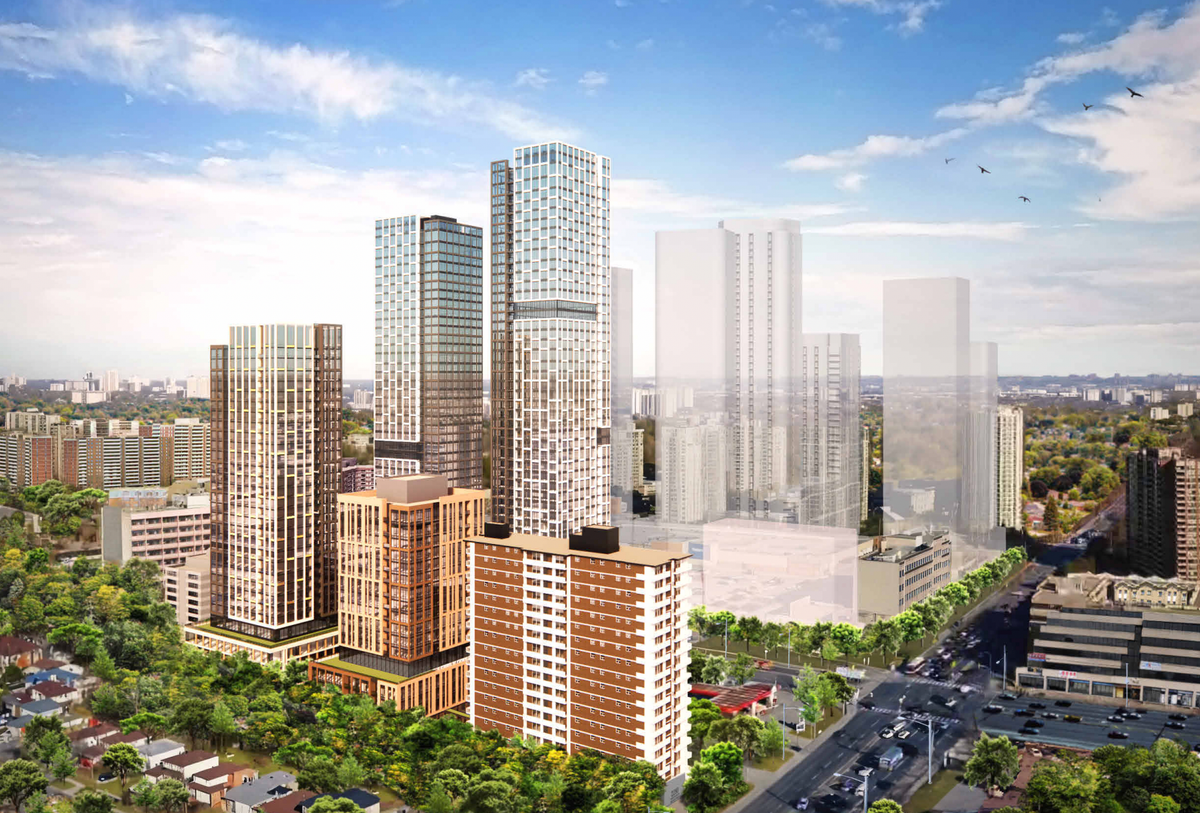A new mixed-use development coming to the city’s northwest end will pilot a unique way to create affordable housing units, one that the builder hopes will pave the way for future development approaches.
The four towers, to be built on a 3.5-acre site at Black Creek Drive and Lawrence, will infuse the neighbourhood with 1,470 units -- a blend of ownership and rental -- 70% of which will be dedicated to deeply affordable housing with incomes below $75,000. The builder, Spotlight Development, is partnering with several not-for-profit organizations to deliver housing to the community, along with supportive services.
Designed by Sweeney + Co Architects, the complex will also include approximately 35,866 sq. ft of essential retail, and 36,959 sq. ft of outdoor community amenities, including a non-profit daycare, patio seating, and community gardens.

Sherry Larjani, President at Spotlight Development, tells STOREYS that when the opportunity to build at this location presented itself, it gave it a “more meaningful and new direction.”
READ: STOREYS’ Real Estate Project of the Year: Reina
“It’s not just that people can’t afford to pay rent, it’s that people can’t afford to become homeowners, they can’t afford to go through with the things they have to do on a daily basis in order to cover their costs, and housing is becoming more and more expensive,” she says. “It becomes a matter of making choices, and having to think about that was something that always bothered me. So I wondered, how do I give back, and how do I create something that could hopefully be modeled after into other projects and be something we can repeat and actually do some good?”
Via its community partners, the project will dedicate a percentage of units to house specific groups; 10% each to Black and Indigenous Canadians, 10% to Habitat for Humanity, 10% to Trillium housing, and 15% to Woodgreen Community Services. Forty-five per cent will go toward servicing all communities, including veterans, through the developer’s not-for-profit arm Spotlight Affordable Ventures.
Each partner was selected “recognizing that communities like Black and Indigenous Canadians have historically been marginalized and face unique roadblocks to home-ownership, an accomplishment that significantly impacts social determinants of health and transformational generational change,” according to a release.

Being able to deliver such large quantities of affordable units -- which go above and beyond the requirements mandated by the city -- requires a “very, very complicated” pro forma, Larjani says. While using the funding from the sale of market units to cost subsidize the deepest affordable units, the project and partners will also be utilizing a number of grants and incentives, and “absolutely everything else that will make this project a financially viable project,” she says.
READ: Rising Interest Rates Are Also Threatening Affordable Housing Development
According to her research, she isn’t aware of other projects with as ambitious a mandate, that is focusing on serving so many specific groups, like Indigenous and veteran populations. “I rarely see housing for veterans, let alone projects dedicated to them,” she says. “So we are encompassing all of that, and we are also bringing in community services to service these families so they can stay homeowners and stay renters, and they can succeed and find jobs and have access to food, have access to care. So all of that, I don’t think I’ve seen a project that does it all in one, with this many partners around the table.”
Overall, Larjani says, the experience of delivering affordable housing has underscored how much more government could -- and should -- be involved. Given that private developers deliver the majority of housing, purpose-built rental and otherwise, government could provide greater incentives to help offset their costs, such as waiving application and development fees.
As well, she says, many of the existing programs designed to deliver affordable units, such as the City of Toronto’s Open Door Program, focus solely on rental. And, while subsidies exist for rental programs, she adds, homeowners’ programs generally do not.
“We are coming up with such creative ideas and ways of doing housing as ownership for different groups with different incomes,” she says. “That’s where we do need those subsidies to come in, or waivers of fees or waivers of charges to come in, so they can help us.”
Lastly, she’d like to see greater alignment at all levels of government to deliver programs, pointing out that often, different funding sources available at the municipal, provincial, and federal levels are dependent on each other.
“I’m hoping that this will set an example… I think this is something we are piloting with this project so we can set the way for more projects like this to happen,” she says. “I think we are trying to open the door for any further conversations with the government so they understand where we are coming from, especially how closely they looked at everything the Housing Affordability Task Force put together, and they idea that they even started that through the provincial government -- and then the federal government coming up with their own programs. We want this to become something where the conversation and dialogue keeps continuing to happen so we all figure out how to work in this industry on projects like this. I consider it more as a pilot project; at least for us, it’s the first of a few projects we have in the pipeline that is going to be based on this same idea and model.”





















